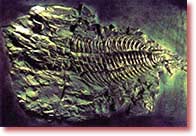The Cambrian Period is the name given to the geological age when all the multi-celled groups living today suddenly emerged. This was so sudden and so wide-ranging that scientists refer to it as the “Cambrian explosion.”
According to the myths of the theory of evolution, life should be like a tree that developed from a single root and then began spreading out its branches. Indeed, this hypothesis is emphasized in Darwinist sources, and the concept of the “tree of life” is frequently used. That is what the theory of evolution claims. But is that really what happened?
Absolutely not! All the animal phyla known today emerged at the same time, in the geological age known as the Cambrian Period. That period lasted some 10 million years, between 520 and 530 million years ago. All animal phyla appeared, fully formed, during that brief space of time!
Fossils found in Cambrian rocks include very different life forms, such as snails, trilobites, sponges, jellyfish, starfish, sea lilies and swimming crustaceans. The great majority of the life forms in these strata have complex systems and advanced physiological structures identical to those of specimens living today, such as eyes, gills and blood circulation. These structures are both very complex and very different.
Cambrian life forms, with more complex structures than many living things today, baffle evolutionists
The theory of evolution maintains that the Cambrian Period is a “too early” period for the biological complexity it exhibits because Darwinist theory claims that the complex structures possessed by living things are acquired gradually, over long periods of time. Accordingly, life forms must have “primitive” features at the beginning of their supposed evolutionary histories and only acquire more advanced ones after a long process of evolution.
But the history of life reveals the exact opposite. The first life forms possess the same complex anatomical features as today’s, such as eyes, antennae, feet, mouths and stomachs. Therefore, “complexity” is a property appearing “at the first moments” of life, not later on.
Berkeley University’s Professor Philip Johnson describes the open inconsistency between Darwinism and this fact revealed by paleontology by saying,
“'Darwinist theory assumes that a species develops within “a triangle of increasingly expanding diversification.” According to this, life began from the first living organism or primitive animal species, diversified increasingly and gave rise to higher categories of biological classification. But animals fossils show us that this triangle actually stands upside-down: Phyla existed all together from the first moment, their numbers declining subsequently.'”
As Philip Johnson has said, rather than phyla developing gradually, all phyla appeared at once and the same time, with some of them later becoming extinct. And all these very different life forms appearing suddenly and flawlessly, means they were created.
All the scientific evidence shows that the first living things on earth did not evolve and develop. They did not evolve from one another and turn into different species.
Cambrian life forms suddenly appeared on the stage of history with no supposed primitive forebears before them.
Cambrian life forms dating back 530 million years ago and containing all the basic structures of the animal kingdom totally refute the theory of evolution. Evolution has ceased to exist in the face of this reality.
Darwinism will seem just as ludicrous to later generations as the stories from previous centuries about the Earth resting on the back of a giant turtle that people once believed in so fervently do to us today. People will fail to understand how Nobel prize-winning professors, teachers and scientists believed in such a farce and lined up behind such nonsense. The 20th Century will be one of shame for all Darwinist circles.


No comments:
Post a Comment